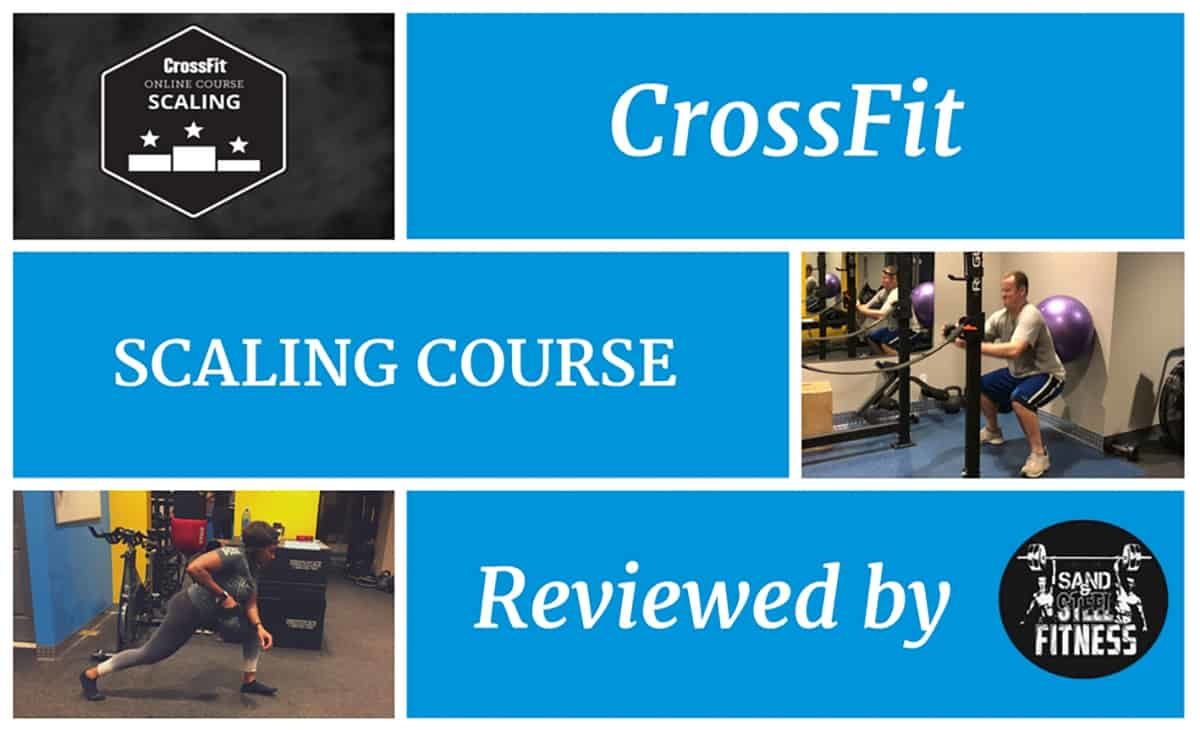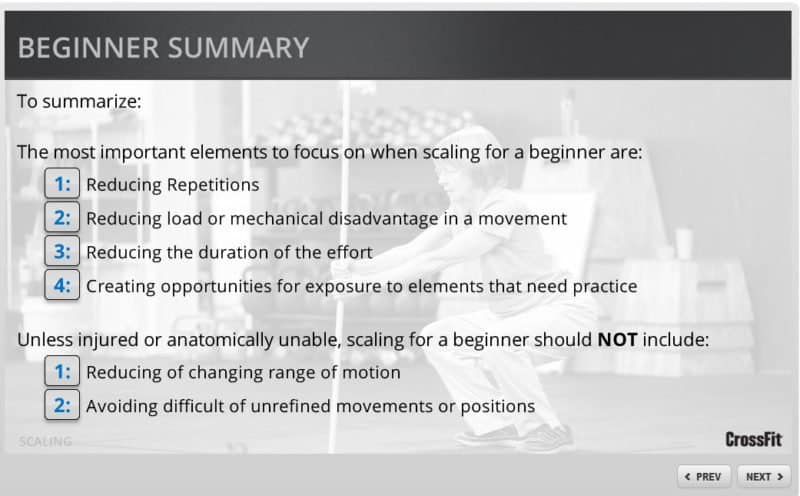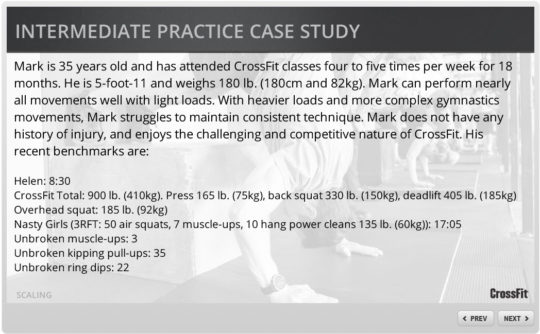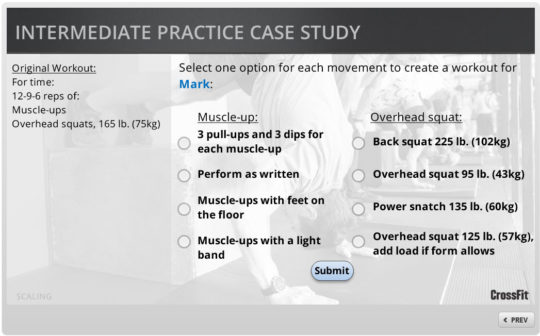The CrossFit Scaling Course teaches and tests CrossFit coaches on how to scale exercises and workouts. I finished the course, and here’s what I thought and what I learned.
The CrossFit Scaling Course is pretty quick for an online course. I finished in it about 90 minutes. It contains about 20 question and answer patterns that are designed as teaching tools. The questions ask the coach to update a workout for a particular athlete based on their past performance.
CrossFit Scaling Course Review Aggregate Rating 56/100
Verdict… not worth it for me specifically, but it is something I’d want my coaches to take.
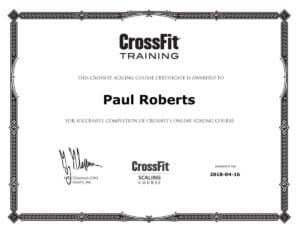
Importance: 60/100
Clarity of Information: 100/100
Ease of Application: 70/100
Score of Material: 60/100
Price: 20/100
Format: 30/100
CrossFit Scaling Course Review in Detail
CrossFit Scaling Course Review: Importance
If you are running a CrossFit affiliate and have athletes at different levels, this course is important. It breaks down scaling into chiefly 5 levels. Notably, no information about how to scale to CrossFit games competitors is included in this course.
Beginners • Intermediate CrossFitters • Retired Athletes and Military • Advanced CrossFitters • Injured Athletes
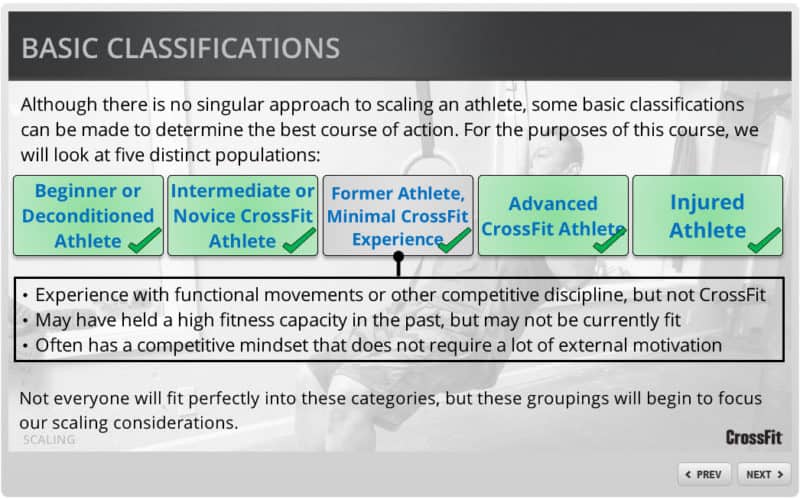
I don’t run a CrossFit Affiliate anymore. I don’t teach group classes very often. As I described in my previous post on Group Classes versus Personal Training, group classes can be very fun and are less expensive than personal training. While I do like the 5-way client profiling system CrossFit suggests, as personal trainer this simply not a useful model. At Sand & Steel we have closer to 60 client archetypes. Since we work one-on-one, we can do create 60 different workout scalings. A group class cannot.
So for a coach that works with clients one-on-one, this course of little importance. However, CrossFit is primarily large class group training. And for the CrossFit coach teaching large format group classes, this course is very important.
View More Articles for Personal Trainers in Alexandria
CrossFit Scaling Course Review: Clarity of Information
CrossFit did a great job of clearly explaining how to scale workouts based on previous attempts. CrossFit does a crystal clear job of explaining how they recommend scaling workouts for people from each of the following groups. For example, here’s how CrossFit suggests scaling for beginners:
See how simple CrossFit makes this. If you have a beginner you should scale down doing the above items. However, you shouldn’t scale down by “Reducing or Changing range of Motion” or “Avoiding difficult or unrefined movements or positions.” [sic]1. Note to CrossFit HQ, run a grammar check on your course, there are obvious distracting typos.]
Sand & Steel differs from CrossFit Group Classes in the way we handle beginners athletes. Most notably we don’t force or even encourage brand new deconditioned clients to do a scaled down version of an existing workout. We write workouts specifically intend for them at their level. CrossFit claims that one can scale a workout to any level. I would say that true, but it’s not optimal for that beginner athlete. That’s where personal training is far superior.
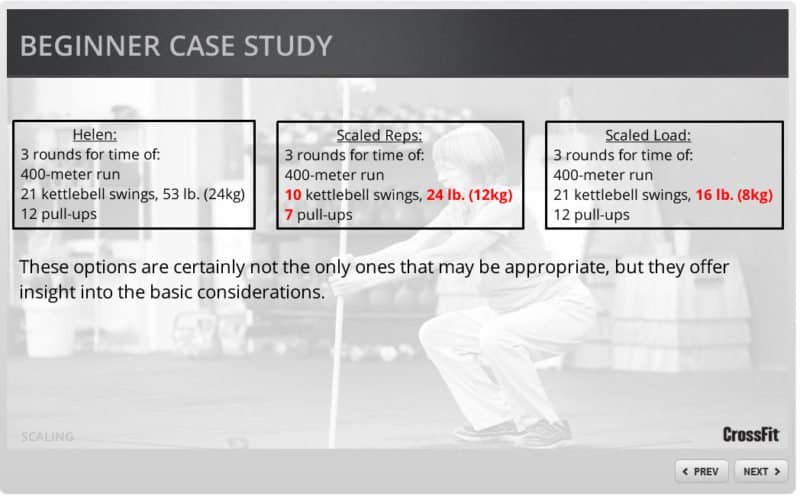
For our intermediate, advanced, and former athletes, Sand & Steel does use a model similar to what this course presents. While we do use some CrossFit style workouts, many of our workouts incorporate other styles (such as TRX, bodybuilding, etc.) which cannot be done in a CrossFit style.
We also really differ from CrossFit standards when it comes to injured athletes. The scaling basically says, preserve as much of the movement as you can, but be sure you don’t cause more damage. CrossFit presumes that the athlete will either recover on his or her own, or seek more intensive 3rd party care. For many residents in Alexandria VA, we are that 3rd party care. IF YOU HAVE INJURED YOURSELF DOING CROSSFIT, WE CAN HELP GET BACK TO CROSSFIT SAFELY AND QUICKLY. Again, through the lens of group class programming, I think CrossFit Scaling suggestions are wise. Because we work one-on-one with clients in mobility and scaling, these guidelines don’t apply to us.
CrossFit Scaling Course Review: Ease of Application
Some certifications provide a lot of esoteric information that cannot really be applied readily in the training environment. For example, I am not sure why many personal training certifications continue to devote several chapters to the anatomy of the cell. All of the information (and there isn’t that much) is immediately useful and practical. Morever, when I teach CrossFit group classes, I would scale precisely as this course suggests.
The only reason I docketed 30 points is because CrossFit really should provide a book with the information in this course for easy reference. It is a pain in the ass to revisit items you already read. The navigation in this course (and all Online Courses) is complete crap. It’s awkward and annoying. Message to CrossFit HQ, “spend a few bucks and send graduates a book with these materials.”
Learning by the Socratic Method. Much of this course is taught by asking the CrossFit coach tough questions based on a hypothetical athlete. The coach has navigate the choices and determine the best answer. This is a strong part of the course, and very practical. Below is one example of the hypotheticals and answers. There are about 20 total in this course.
CrossFit Scaling Course Review: Scope of Information
I like that CrossFit boiled this course down to the bare essentials. From the context of coaching a group class, CrossFit hit all the main points someone needs to consider in terms of scaling a workout.
There is almost no discussion of scaling workout programs themselves. Additionally the course itself is very short, but it’s pithy. This wouldn’t have been an issue for me, but the course is overpriced for what it is.
CrossFit Scaling Course Review: Price
I gave pricing my lowest score, because this course isn’t worth $60. It didn’t cost CrossFit very much to make. It didn’t take CrossFit much research to do. The course looks ugly, the navigation is a bear, and it’s very short. Honestly, I feel that coaches like me that have spent $4000 on CrossFit certifications and courses should just get this course for free. It could have simply been a great 150 page booklet. If you are running an affiliate and considering making your coaches takes this course, I could see the value in that — even if you have the foot the bill. It’ll help your coaches scale your programming better… and that’s valuable.
CrossFit Scaling Course Review: Course Format
I’ve mentioned this point several times already, CrossFit “online course” applet program sucks. I’ve taken a lot of online courses, and even written several myself. I don’t like this online course software, and I doubt you will either. It doesn’t work on IOS devices. You can start the course, but the course hangs midway through.
CrossFit Scaling Course Review: Overall
Affiliate owners, you should make your coaches take this course. Personal Trainers, there are better online courses to purchase.
CrossFit Scaling Course Review: Principle Points
- Keep as much of the original exercise mechanics as you can.
- Reduce load and/or reps to preserve technique and avoid injury.
- Take care to give previous athletes a challenging workout that is safe for them.
- Ensure that your injured athletes have the closest version of the workout possible. Do not let them exercise in pain.
